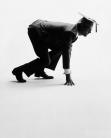Equilibrium and Proprioception
Equilibrium and Proprioception :
Proprioception (kinesthesia) establishes the position of limbs and underlies the ability to assume and maintain posture, to move about in the environment, to manipulate objects and to be coordinated. These senses did not figure prominently in the traditional account of senses because they have no external sources of adequate stimulation. They do have identifiable and understood sensory receptors. Both play an important role in maintaining posture and balance.
PERCEPTION
Perception is the primary process by which we obtain knowledge about the world. It involves the activity of our senses in responding to external stimulation. Perception is a skill or set of skills, not simply the passive reception of external stimulation. The process of structuring these stimuli into objects we can perceive is called perceptual organisation. There are a number of principles to perceptual organisation.
Figure and Ground
Gestalt psychologists identified the tendency to differentiate between figure and ground. The figure being the part of an image which we notice prominently, opposed to the background, the ground. This theory applies to visual items.
More Essays on Philosophy
Equilibrium and Proprioception :
Equilibrium and Proprioception To HOME PAGE
| Share this page: | ||

| Share this page: | ||
Related Links : Equilibrium and Proprioception
Would you prefer to share this page with others by linking to it?